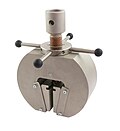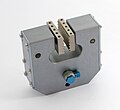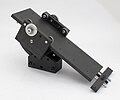Grip
A chucking tool are clamping means for securing and making a frictional connection between a machine and a workpiece ( a vice or spin chuck ), a tool (e.g., chuck ), a machine tool or a sample of material (material testing, testing of materials , in particular for tensile testing ).
Designs
Depending on the design, a distinction is made between scissor clamping tools, wedge clamping tools and screw clamping heads.
Scissor and wedge clamping tools are usually designed to be self-locking due to suitable dimensions .
Further designs are: eccentric roller clamping devices, thread specimen and shoulder specimen clamping devices as well as rope clamping devices.
With mechanical clamping tools, the clamping force is applied to the clamping jaws via levers, eccentrics, wedges or threaded spindles. In addition, there are pneumatic and hydraulic clamping tools which enable particularly fast clamping processes and / or very high clamping forces.
Requirement
A high-quality clamping tool must not deform or damage the clamped part, but must guarantee a connection that can be reliably established and released again. Especially when creating a force- displacement diagram, slippage in the clamping device would result in incorrect recording of the displacement and thus unacceptable errors in the measurement. Unsuitable fastenings of the material sample, which damage the sample, reduce the breaking load and render measurements worthless.
Specialized manufacturers offer an enormous range of tried and tested clamping devices for use on any universal testing machine and are promptly developing further special devices to meet customer-specific requirements.
Countless international and national standards relate to testing technology and prescribed devices for measurement , here are just a few examples:
- EN ISO 75: Plastics - Determination of the heat deflection temperature
- EN ISO 604: Plastics - Determination of printing properties
- EN ISO 6892: Metallic materials - tensile test (formerly EN 10002)
- EN ISO 13934: Textiles - Tensile properties of textile fabrics
- EN ISO 14126: Fiber-reinforced plastics - Determination of the compressive properties in the laminate plane
- EN ISO 20482: Metallic materials - Sheets and strips - Erichsen cupping test
- DIN 52186: Testing of wood; Bending test
- DIN 53121: Testing of paper, cardboard and paperboard - Determination of the bending stiffness according to the beam method
- DIN 53292: Testing of core assemblies; Tensile test perpendicular to the surface layer level
- DIN 55437: testing, cardboard, paper, cardboard
- ISO 3303: Rubber or plastic coated fabrics; Determination of burst strength
literature
- Erich Siebel: Handbook of materials testing. Springer, Berlin 1958.
- Ralf-Dieter Reumann: Test methods in textile technology. 1st edition. Springer, Berlin 2000, ISBN 3540661476 .










